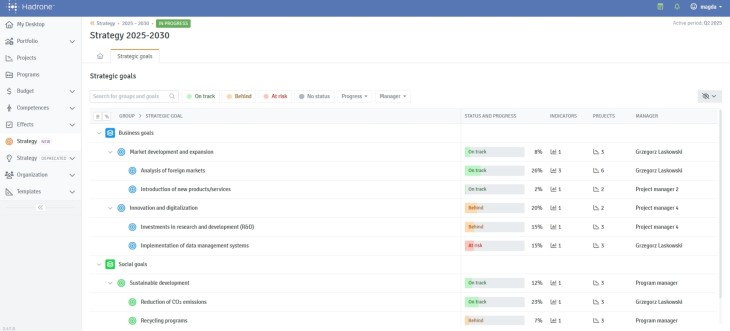
In the previous article, I described how a strategy can be planned by breaking down strategic objectives, defining their indicators, and identifying the projects required to achieve those objectives.
In this article, I will focus on how to report on the progress of strategy implementation and how to monitor the achievement of individual objectives, with particular attention to the progress of projects linked to those objectives and the performance of the associated key performance indicators (KPIs).
When considering how to report and monitor strategy execution, it is worth reflecting on the following questions:
- On what basis will we assess the progress of achieving strategic objectives?
- How often will we provide data on progress and evaluate the current state of objective achievement?
- What exactly will strategy monitoring consist of?
How to assess the progress of achieving strategic objectives?
The assessment of progress in achieving a strategic objective is based on determining the percentage of completion and the current status of the objective (On Track, Delayed, At Risk). In addition, a descriptive commentary is provided to help explain and justify the assessment of the objective’s progress (see Figure 1).
Figure 1. Assessment of objective implementation.
Fig. 1. Assessment of objective implementation in Hadrone PPM software
Source: Hadrone PPM software (www.hadrone.com)
Such an assessment may be based solely on the subjective judgment of the person responsible for achieving a given objective, or it may additionally rely on:
- the progress of projects linked to that objective,
- the progress of the objective’s key performance indicators (KPIs).
Including projects in the assessment of an objective requires providing information on the current progress of each project, as well as considering the weight of each project in the overall assessment of the objective’s achievement (see Fig. 2).
Figure 2. Progress of objective achievement and progress of related projects.
Fig. 2. Progress of objective achievement and progress of related projects in Hadrone PPM
Source: Hadrone PPM software (www.hadrone.com)
In turn, including indicators in the assessment of an objective requires providing information on the current progress of each indicator, optionally with forecasted indicator values (both numerical and descriptive), as well as considering the weight of each indicator in the achievement of the given objective (see Fig. 3 and Figs. 4a and 4b).
Figure 3. Progress of objective achievement and progress of related indicators.
Fig. 3. Progress of objective achievement and progress of related indicators in Hadrone PPM
Source: Hadrone PPM software (www.hadrone.com)
Figure 4a. Reporting of indicator values (table).
Fig. 4a. Reporting of indicator values (table) in Hadrone PPM
Source: Hadrone PPM software (www.hadrone.com)
Figure 4b. Reporting of indicator values (chart).
Fig. 4b. Reporting of indicator values (chart) in Hadrone PPM
Source: Hadrone PPM software (www.hadrone.com)
How often should data on the progress of achieving objectives be provided and their status evaluated?
Each organization adopts a certain cycle (e.g., monthly, quarterly, semi-annual, or annual) in which information on the progress of strategy implementation is collected. This cycle is usually defined already at the strategy planning stage.
The reporting of progress on objectives itself may take place more frequently (e.g., monthly, or even daily if the data is updated automatically), but it is within this reporting cycle (e.g., quarterly or semi-annual) that the data on the progress of objectives will be summarized and analyzed.
Figure 5. presents update entries regarding the monthly progress of an objective, while Figure 6. shows a summary of the status of the objective at the end of the reporting period (in this case, a quarter).
Figure 5. Update entries on the progress of objective achievement.
Fig. 5. Update entries on the progress of objective achievement in Hadrone PPM
Source: Hadrone PPM software (www.hadrone.com)
Figure 6. Summary of the status of strategic objective achievement at the end of the reporting period.
Fig. 6. Summary of the status of strategic objective achievement at the end of the reporting period
Source: Hadrone PPM software (www.hadrone.com)
As a result, we will know the status of each objective at the end of every period (e.g., quarter, half-year, or year) and will be able to analyze how this status has changed over time (with any desired level of detail).
How to monitor strategy implementation?
Monitoring strategy implementation is based on information about the progress of objectives and sub-objectives (see Fig. 7).
Figure 7. Monitoring of strategy implementation.
Fig. 7. Monitoring of strategy implementation in Hadrone PPM
Source: Hadrone PPM software (www.hadrone.com)
For each objective, we can quickly check its status (progress %, state, and description), whether any indicators (KPIs) or projects are assigned to it, and who is responsible for its achievement. Filters make it easy to find objectives that require our attention (e.g., delayed or at risk), have a specific level of completion (%), or are assigned to a particular person (manager).
During strategy monitoring, we can always quickly drill down into the details of a given objective to understand its scope, responsible persons, related indicators and projects, as well as the progress made so far (see Fig. 8).
Figure 8. Monitoring of strategy implementation - objective details.
Fig. 8. Monitoring of strategy implementation – objective details
Source: Hadrone PPM software (www.hadrone.com)
Effective monitoring of strategy implementation requires making decisions about the basis on which the progress of individual strategic objectives will be assessed (solely subjectively, or also by including the progress of related projects and indicators), as well as defining the cycle in which the progress of objectives will be reported and analyzed. It is also worth considering the method of providing progress data (in particular, actual and forecasted indicator values), including integrations with existing systems, to minimize manual work related to maintaining the up-to-date status of objectives.
If the concept of planning and reporting strategic objectives described in this and the previous article, „Planning strategy in connection with a project portfolio.”, has caught your interest, we invite you to get in touch (www.hadrone.com). We will be happy to demonstrate live how you can manage your organization’s strategy in Hadrone PPM software, in connection with projects and objective performance indicators.






